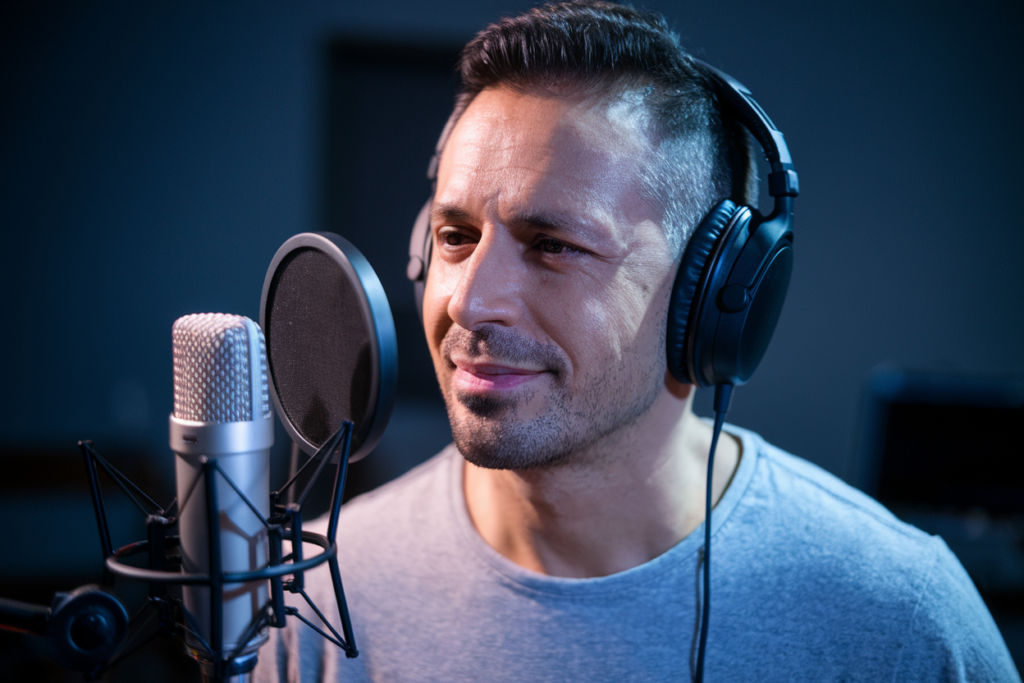Key Takeaways
- Cultural Nuances Matter: Localization involves more than translation; it requires a deep understanding of cultural references and idiomatic expressions that may not have direct equivalents between Turkish and English.
- Language Structure Differences: The agglutinative nature of Turkish contrasts sharply with the simpler grammatical structures of English, complicating both translation and localization efforts, especially in voiceovers.
- Tone and Formality Variations: Adapting tone appropriately is crucial, as Turkish often uses more formal speech compared to the casual approach commonly found in English communication.
- Humor Does Not Translate Easily: What’s humorous or relatable in one culture may not resonate in another; careful adaptation is needed to maintain comedic intent during localization.
- Technological Limitations: Relying solely on machine translation can lead to inaccuracies in capturing context or cultural nuances; working with skilled bilingual professionals enhances quality.
- User Testing Is Essential: Engaging native speakers for feedback improves content relatability and effectiveness, ensuring that localized material connects well with the target audience.
Ever tried translating a simple phrase from Turkish to English and found yourself scratching your head? Localization challenges between Turkish and English can be surprisingly complex. It’s not just about swapping words; it’s about capturing culture, context, and nuance that often get lost in translation.
Overview of Localization Challenges
Localization between Turkish and English presents unique challenges that go beyond simple translation. Understanding cultural nuances plays a crucial role in ensuring accurate communication. For instance, idiomatic expressions that resonate in one language may not have direct equivalents in the other. This disparity can lead to misunderstandings if not carefully addressed.
Cultural references often require adaptation for the target audience. What’s humorous or relatable in Turkish might fall flat when translated directly into English. Tailoring content to suit local customs and expectations is vital for effective messaging.
Another challenge arises with grammatical structures and sentence construction. Turkish employs agglutination, where multiple suffixes create complex words, whereas English tends toward simpler word forms. This difference can complicate the localization process, necessitating creative solutions to convey the original intent clearly.
Additionally, tone and formality levels differ significantly between these languages. In Turkish, more formal speech may be expected in certain contexts compared to English’s casual approach. Adjusting tone appropriately is essential for maintaining engagement and respect within localized content.
In voiceover work, these localization challenges become even more pronounced. Selecting a voice talent who understands both languages’ intricacies ensures that the intended message resonates with audiences effectively. A skilled voice artist recognizes how intonation and emphasis shift based on cultural context, enhancing overall delivery.
By acknowledging these localization challenges early in your project planning, you set the stage for successful cross-cultural communication that captivates your audience while respecting their linguistic background.
Language Structure Differences
Localization between Turkish and English presents unique challenges due to significant differences in language structure. Understanding these distinctions is crucial for effective communication, especially when it comes to voiceover work.
Syntax and Grammar
Turkish features an agglutinative structure, meaning it forms words by adding multiple suffixes to a root word. This results in long, complex words that carry extensive meanings. In contrast, English relies on simpler grammatical structures with more straightforward sentence formations. For instance, while you might express an idea in a single Turkish word, it often requires several English words to convey the same message. This difference complicates not only translation but also localization efforts in voiceovers where timing and natural flow are vital.
When working with voice talent familiar with both languages, consider their ability to adapt these structural nuances. They must effectively capture the essence of the original text while ensuring it sounds natural in the target language.
Vocabulary Nuances
Vocabulary differences between Turkish and English can lead to misunderstandings if not addressed properly. Certain Turkish words may lack direct equivalents in English or possess cultural connotations that don’t translate well. For example, idiomatic expressions often hold specific meanings within their cultural context that are difficult to articulate directly in another language.
For successful localization projects involving voice actors or voice artists, selecting professionals who grasp these vocabulary nuances is essential. They need to navigate these subtleties skillfully so that your message resonates authentically with your audience. If they understand local slang or colloquial terms used in either language, they can enhance relatability and engagement during recordings.
By recognizing these linguistic challenges early on and choosing skilled voice over talent who can adapt accordingly, you’ll streamline your localization process and ensure clear communication across cultures.
Cultural Context and Implications
Understanding cultural context is crucial for effective localization between Turkish and English. This goes beyond word-for-word translation; it involves grasping the societal norms and values that shape each language.
Societal Norms and Values
Turkish culture emphasizes community, respect, and tradition, often reflected in language use. You might notice a more formal tone when addressing elders or figures of authority in Turkish. When localizing content, consider how these norms translate to English. Casual expressions used in the U.S. may come off as disrespectful if not carefully adapted.
Different cultures also prioritize various aspects of communication, such as emotional expressiveness versus directness. In your voiceover projects, tailoring scripts to align with these cultural nuances enhances relatability. A voice actor familiar with both cultures can navigate these subtleties effectively, ensuring your message resonates with the audience.
Humor and Idiomatic Expressions
Humor plays a unique role in both languages but often doesn’t translate directly. What’s funny in one culture may fall flat in another due to differing comedic conventions or references. For instance, puns that work well in Turkish can become confusing when translated into English.
When working on voiceovers that include humor or idiomatic expressions, choosing a voice artist who understands these differences makes all the difference. They’ll know how to deliver lines authentically while maintaining the intended humor or sentiment. It isn’t just about translating words; it’s about capturing the essence of what makes those expressions resonate culturally.
By recognizing these cultural implications early in your project planning process—with an eye on selecting skilled voice talent—you set yourself up for successful cross-cultural communication that truly connects with diverse audiences.
Technological Considerations
Localization involves more than just translating text; it encompasses the entire process of adapting content for different cultures and languages. In this digital age, technological considerations play a pivotal role in ensuring effective localization between Turkish and English.
Tools and Software Limitations
When adapting voiceovers from Turkish to English, you’ll encounter limitations within translation tools and software. Many popular platforms might not handle idiomatic expressions or cultural nuances effectively. You can’t always rely on them for high-quality translations, especially when dealing with humor or culturally specific references. Specialized localization tools can help bridge gaps, but their effectiveness varies based on the complexity of the source material. Selecting voice talent familiar with both languages ensures that subtleties are communicated clearly, enhancing audience engagement.
Machine Translation Challenges
Machine translation offers speed but often lacks accuracy in conveying context. For example, Turkish’s agglutinative nature complicates direct translations into English, where word structures differ significantly. This challenge becomes even more pronounced during voiceover projects—timing is crucial as translated scripts need to sync perfectly with audio delivery. If a machine-generated script misses cultural references or tonal variations common in Turkish, it risks alienating your audience instead of connecting with them. Collaborating closely with skilled voice actors adept at navigating these complexities can transform your project into one that resonates deeply across linguistic divides.
By considering these technological aspects during the localization process, you position yourself to create compelling content that speaks directly to your target audience’s hearts and minds.
Solutions and Best Practices
Navigating localization challenges between Turkish and English requires strategic solutions. Understanding the intricacies of both languages allows for effective communication that resonates with your target audience.
Collaborative Translation Approaches
Consider involving bilingual professionals who are well-versed in both cultures. Collaborating with translators can ensure that idiomatic expressions and cultural references are accurately conveyed, maintaining their intended meaning. This approach not only enhances linguistic accuracy but also enriches the content’s relatability. In voiceover projects, selecting voice talent familiar with these nuances can significantly improve the final product’s authenticity.
User Testing and Feedback
User testing provides invaluable insights into how well your localized material connects with the audience. By gathering feedback from native speakers, you can identify areas needing improvement, such as tone adjustments or cultural sensitivities. Engaging voice actors during this phase is crucial; they can help gauge whether the delivery aligns with local expectations and preferences. This iterative process fosters a deeper understanding of audience needs, ensuring your message hits home effectively every time.
Conclusion
Successfully navigating localization challenges between Turkish and English requires a keen understanding of cultural nuances and language intricacies. By prioritizing collaboration with bilingual professionals and engaging experienced voice talent, you can ensure that your content resonates deeply with your audience.
Don’t underestimate the importance of user feedback in this process. It’s essential to test how well your localized material connects with the intended demographic. Remember that each language carries its own unique context, so adapting humor tone and expressions is crucial for effective communication.
Embracing these best practices will not only enhance relatability but also foster a meaningful connection with diverse audiences, ensuring your message is both clear and impactful.
Frequently Asked Questions
What is localization in translation?
Localization is the process of adapting content to fit the cultural, linguistic, and contextual needs of a target audience. It goes beyond mere word-for-word translation, focusing on ensuring that idiomatic expressions and cultural references resonate with local users.
Why are cultural nuances important in translation?
Cultural nuances play a significant role in effective communication. They influence how messages are perceived and understood. Ignoring these subtleties can lead to misunderstandings or loss of meaning, particularly with humor and relatability.
What challenges arise when translating from Turkish to English?
Translating from Turkish to English presents challenges like grammatical differences, idiomatic expressions without direct equivalents, and varying tones. The agglutinative nature of Turkish can complicate sentence structure compared to English.
How does tone affect localization between languages?
Tone impacts how messages are received by audiences. Different cultures may have distinct expectations regarding formality and respect in language use. Adapting tone appropriately ensures better engagement with the target audience.
Why is voice talent selection crucial for localization?
Choosing skilled voice talent is essential for maintaining authenticity and relatability in localized content. Voice actors knowledgeable about cultural context can effectively convey intended meanings while navigating linguistic complexities.
Can machine translation be relied upon for localization?
Machine translation has limitations; it often struggles with idiomatic phrases and cultural nuances. Relying solely on technology may result in inaccuracies that undermine effective communication across languages.
What best practices enhance successful localization efforts?
Best practices include collaborating with bilingual professionals familiar with both cultures, engaging voice actors during testing phases, and using user feedback to refine materials for better audience connection.
How do societal norms influence language use in translations?
Societal norms shape language use by dictating what is considered respectful or appropriate within a culture. Understanding these norms helps translators adjust their work accordingly to ensure relevance and sensitivity.
What role does humor play in cross-cultural communication?
Humor varies significantly across cultures due to different references and contexts. Successful localization must consider these variations so that comedic elements translate well without losing their essence or appeal.
How can user testing improve localized content effectiveness?
User testing provides valuable insights into how well translated material resonates with the target audience. Involving local speakers during this phase helps assess if the delivery aligns with community expectations.







